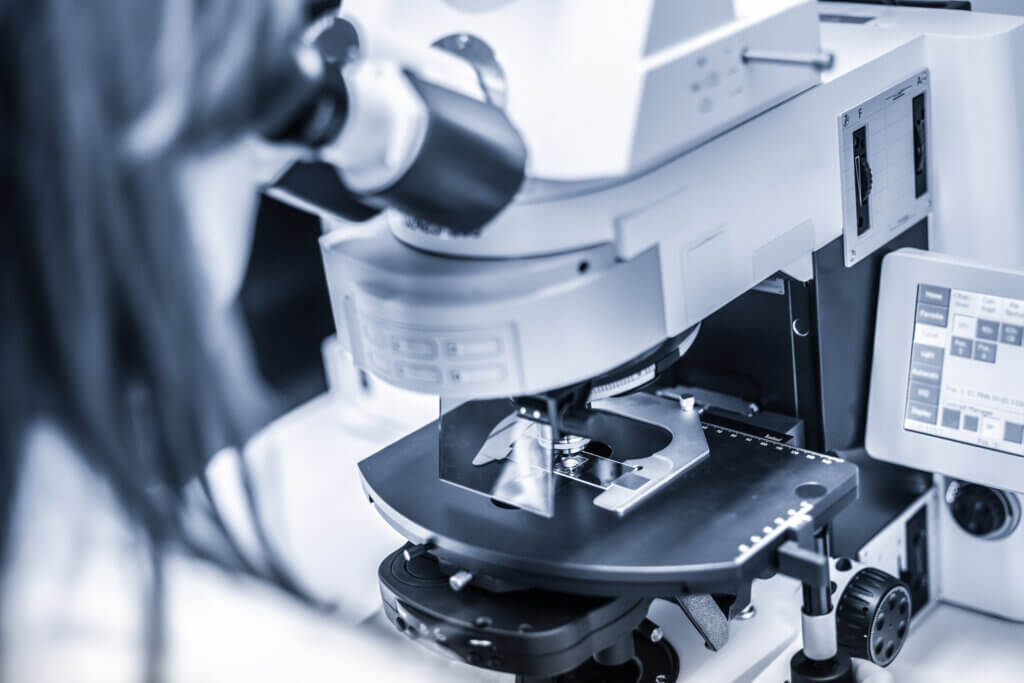Androgen Insensitivity Syndrome

Androgen insensitivity syndrome (AIS) is a rare genetic disorder that is classified under disorders of sexual development. It is characterized by the “feminization” of the external genitalia at birth. The appearance of these varies from patient to patient.
If it isn’t treated during childhood, the syndrome usually leads to anxiety during puberty, both for the patient and for their family. It’s a rare condition, so rare that the National Organization for Rare Disorders states that only 1 in 99,000 live newborns have the syndrome. We’ll tell you everything that is known about it.
Causes of androgen insensitivity syndrome
As experts point out, androgen insensitivity syndrome develops as a result of loss-of-function mutations in the androgen receptor (AR) coding sequence.
This mutation is linked to the X chromosome of the androgen receptor gene, resulting in the dysfunction of androgen receptors and hormonal resistance.
In practice, the syndrome causes a loss of virilization or infertility in 46 XY males, specifically in those with functional testicles and adequate testosterone production. To be precise, the syndrome isn’t homogeneous; several of them have been described. They are as follows:
- Complete Androgen Insensitivity Syndrome (CAIS): Characterized by typical characteristic external genitalia.
- Partial Androgen Insensitivity Syndrome (PAIS): Characterized by manifesting predominantly female, male, or ambiguous external genitalia.
- Mild Androgen Insensitivity Syndrome (MAIS): In these cases, the patient develops typical male external genitalia.
In very simple terms, when a person has androgen insensitivity syndrome, they are less responsive to masculinity-giving substances (androgens).
Androgens are the hormones responsible for stimulating male sexual characteristics. Testosterone, dihydrotestosterone, androstenedione, and dehydroepiandrosterone are some of them.
In some contexts, the syndrome is known as intersex, hermaphroditism, or testicular feminization syndrome. These categories are considered inadequate, at least in the medical context.
Despite this, they’re easier to understand for the general population; hence their popularity. As we have already explained, the carrier gene is located on the X chromosome, so women are in charge of inheriting it.
A female carrier of the gene has a 25% chance of having a carrier daughter, a 25% chance of having a non-carrier daughter, a 25% chance of having a son with the syndrome, and a 25% chance of having a healthy son.
If the male carrier of the gene manages to have female offspring, the gene will be passed on to them. If you have male offspring, the gene will not be passed on.
Symptoms of androgen insensitivity syndrome

There are different degrees of intensity of the syndrome, and even in patients with the same degree of intensity, the clinical manifestations can be very different. Family history or genetic tests are taken as a warning sign, and, in general, specialists suggest paying attention to the following characteristics:
- Undermasculinization of the external genitalia at birth.
- Absence of extragenital abnormalities.
- Two non-dysplastic testes.
- Impaired virilization at puberty (spermatogenesis or somatic virilization).
- A short, or shallow, vagina.
- Rudimentary or absent Müllerian structures (cervix, uterus, and fallopian tubes).
Most cases go undetected until the youngster reaches puberty. In cases of complete androgen insensitivity, girls manifest normal external genitalia. However, their chromosomes are XY.
For this reason, they don’t experience menarche and other signs of sexual development (such as pubic hair, since its growth is regulated by testosterone). They don’t have a uterus, and so they’re infertile.
Cases of partial androgen insensitivity have much more characteristic and variable symptoms. Many of them can be detected before puberty. For example, the person may have a micropenis, hypospadias (opening of the urethra in places other than the end of the glans penis), and cryptorchidism (undescended testicle). Other symptoms are:
- Breast growth during puberty
- An enlarged clitoris (especially during puberty)
- Fused labia
- Forked scrotum
Finally, episodes of mild androgen insensitivity are not characterized by changes in the external genitalia. These are normative, although some changes can occur during puberty. The most common is gynecomastia.
As we have already noted, the condition differs in these three types of the syndrome and no two cases are identical.
Diagnosis of androgen insensitivity syndrome

There are no standardized criteria to diagnose androgen insensitivity syndrome due to the variability of the condition in patients. It can be suspected by the changes in the internal or external genitalia, but other disorders or diseases can cause these changes, and must be taken into account too.
Genetic testing helps consolidate initial observations, especially when it comes to a full manifestation of the syndrome (by detecting that a patient with perfect female external genitalia is XY). They can also evaluate the levels of hormones in the body or perform a semen analysis (the latter test in adult men).
To clear up any remaining doubts, one can look for specific mutations in the androgen receptor genes, or opt for a gonadal biopsy. The results of all these tests will allow the specialist to diagnose the syndrome. Many cases are detected during puberty and adulthood, although it’s also possible to make the diagnosis during childhood.
Treatment options
Experts recommend a holistic approach to the syndrome that takes in the patient’s physiological, psychological, and social needs. Indeed, both the child and the parents need to make complicated decisions that, in many cases, must be made quickly to avoid complications on all these levels.
Parenting sex assignment is perhaps one of the most difficult, although it’s followed by others such as surgical interventions and plastic surgery.
The intake of androgen or estrogen supplements is assessed according to each case, although these are often chosen during puberty. Interventions such as gonadectomy, vaginal dilation, vaginoplasty, genitoplasty, correction of undescended testicles, and correction of hypospadias are just a few options that can be considered.
Since each case is different, the specialist determines the route to take after a diagnosis based on a consultation with the parents and the patient (when appropriate).
Psychological support is very important, due to the fact that many patients suffer a crisis of gender identity or sexual identity during puberty or adulthood. This is why the holistic approach is so important.
Androgen insensitivity syndrome (AIS) is a rare genetic disorder that is classified under disorders of sexual development. It is characterized by the “feminization” of the external genitalia at birth. The appearance of these varies from patient to patient.
If it isn’t treated during childhood, the syndrome usually leads to anxiety during puberty, both for the patient and for their family. It’s a rare condition, so rare that the National Organization for Rare Disorders states that only 1 in 99,000 live newborns have the syndrome. We’ll tell you everything that is known about it.
Causes of androgen insensitivity syndrome
As experts point out, androgen insensitivity syndrome develops as a result of loss-of-function mutations in the androgen receptor (AR) coding sequence.
This mutation is linked to the X chromosome of the androgen receptor gene, resulting in the dysfunction of androgen receptors and hormonal resistance.
In practice, the syndrome causes a loss of virilization or infertility in 46 XY males, specifically in those with functional testicles and adequate testosterone production. To be precise, the syndrome isn’t homogeneous; several of them have been described. They are as follows:
- Complete Androgen Insensitivity Syndrome (CAIS): Characterized by typical characteristic external genitalia.
- Partial Androgen Insensitivity Syndrome (PAIS): Characterized by manifesting predominantly female, male, or ambiguous external genitalia.
- Mild Androgen Insensitivity Syndrome (MAIS): In these cases, the patient develops typical male external genitalia.
In very simple terms, when a person has androgen insensitivity syndrome, they are less responsive to masculinity-giving substances (androgens).
Androgens are the hormones responsible for stimulating male sexual characteristics. Testosterone, dihydrotestosterone, androstenedione, and dehydroepiandrosterone are some of them.
In some contexts, the syndrome is known as intersex, hermaphroditism, or testicular feminization syndrome. These categories are considered inadequate, at least in the medical context.
Despite this, they’re easier to understand for the general population; hence their popularity. As we have already explained, the carrier gene is located on the X chromosome, so women are in charge of inheriting it.
A female carrier of the gene has a 25% chance of having a carrier daughter, a 25% chance of having a non-carrier daughter, a 25% chance of having a son with the syndrome, and a 25% chance of having a healthy son.
If the male carrier of the gene manages to have female offspring, the gene will be passed on to them. If you have male offspring, the gene will not be passed on.
Symptoms of androgen insensitivity syndrome

There are different degrees of intensity of the syndrome, and even in patients with the same degree of intensity, the clinical manifestations can be very different. Family history or genetic tests are taken as a warning sign, and, in general, specialists suggest paying attention to the following characteristics:
- Undermasculinization of the external genitalia at birth.
- Absence of extragenital abnormalities.
- Two non-dysplastic testes.
- Impaired virilization at puberty (spermatogenesis or somatic virilization).
- A short, or shallow, vagina.
- Rudimentary or absent Müllerian structures (cervix, uterus, and fallopian tubes).
Most cases go undetected until the youngster reaches puberty. In cases of complete androgen insensitivity, girls manifest normal external genitalia. However, their chromosomes are XY.
For this reason, they don’t experience menarche and other signs of sexual development (such as pubic hair, since its growth is regulated by testosterone). They don’t have a uterus, and so they’re infertile.
Cases of partial androgen insensitivity have much more characteristic and variable symptoms. Many of them can be detected before puberty. For example, the person may have a micropenis, hypospadias (opening of the urethra in places other than the end of the glans penis), and cryptorchidism (undescended testicle). Other symptoms are:
- Breast growth during puberty
- An enlarged clitoris (especially during puberty)
- Fused labia
- Forked scrotum
Finally, episodes of mild androgen insensitivity are not characterized by changes in the external genitalia. These are normative, although some changes can occur during puberty. The most common is gynecomastia.
As we have already noted, the condition differs in these three types of the syndrome and no two cases are identical.
Diagnosis of androgen insensitivity syndrome

There are no standardized criteria to diagnose androgen insensitivity syndrome due to the variability of the condition in patients. It can be suspected by the changes in the internal or external genitalia, but other disorders or diseases can cause these changes, and must be taken into account too.
Genetic testing helps consolidate initial observations, especially when it comes to a full manifestation of the syndrome (by detecting that a patient with perfect female external genitalia is XY). They can also evaluate the levels of hormones in the body or perform a semen analysis (the latter test in adult men).
To clear up any remaining doubts, one can look for specific mutations in the androgen receptor genes, or opt for a gonadal biopsy. The results of all these tests will allow the specialist to diagnose the syndrome. Many cases are detected during puberty and adulthood, although it’s also possible to make the diagnosis during childhood.
Treatment options
Experts recommend a holistic approach to the syndrome that takes in the patient’s physiological, psychological, and social needs. Indeed, both the child and the parents need to make complicated decisions that, in many cases, must be made quickly to avoid complications on all these levels.
Parenting sex assignment is perhaps one of the most difficult, although it’s followed by others such as surgical interventions and plastic surgery.
The intake of androgen or estrogen supplements is assessed according to each case, although these are often chosen during puberty. Interventions such as gonadectomy, vaginal dilation, vaginoplasty, genitoplasty, correction of undescended testicles, and correction of hypospadias are just a few options that can be considered.
Since each case is different, the specialist determines the route to take after a diagnosis based on a consultation with the parents and the patient (when appropriate).
Psychological support is very important, due to the fact that many patients suffer a crisis of gender identity or sexual identity during puberty or adulthood. This is why the holistic approach is so important.
- Gottlieb, B., & Trifiro, M. A. Androgen insensitivity syndrome. 2017.
- Lanciotti, L., Cofini, M., Leonardi, A., Bertozzi, M., Penta, L., & Esposito, S. Different clinical presentations and management in complete androgen insensitivity syndrome (CAIS). International journal of environmental research and public Health. 2019; 16(7): 1268.
- Singh, S., & Ilyayeva, S. Androgen Insensitivity Syndrome. 2019.
Este texto se ofrece únicamente con propósitos informativos y no reemplaza la consulta con un profesional. Ante dudas, consulta a tu especialista.







